Art Commission, In Transition, Takes Hiatus
Ann Arbor public art commission meeting (June 18, 2014): In what might be their last formal meeting for the foreseeable future, the city’s public art commissioners discussed their role in the context of ongoing transitions for the public art program.
One aspect of that transition is the departure of the part-time public art administrator, Aaron Seagraves. His current contract ends on June 30 – the final day of the current fiscal year. Seagraves has been working as the public art administrator on a contract basis since May of 2011.
In addition, one of the art commissioners – Ashlee Arder, who was appointed in March of 2013 – has resigned because of a move to Detroit. She did not attend the June 18 meeting.
Six of the nine commissioners who were present at the meeting approved a resolution about AAPAC’s near-term future. It states that the commission “will not initiate any new public arts projects, nor take any action to seek public or private funds for new projects, until it receives: direction on implementing a transition, a plan to support the Public Art Commission in the furtherance of public art, and guidelines for the funding and management of public art projects…” The resolution also states that AAPAC won’t meet until feedback is needed on the transition plan or for ongoing projects.
AAPAC chair Bob Miller, who introduced the resolution, described it as a way “to tie things up in a neat package for us, until the city has a clear direction for us to move forward.”
In other action, the commission authorized using $10,981 for a project called “PowerArt,” to be administered by the nonprofit Arts Alliance in response to a request by the Ann Arbor Downtown Development Authority. The DDA is contributing $20,000 to the first phase of the project, which involves wrapping eight traffic signal boxes in the DDA district with vinyl printed replicas of artwork. The expenditure from the city is not from Percent for Art funds, but rather from money donated to the city for public art, and held by the Ann Arbor Area Community Foundation.
Discussion among commissioners focused on the fact that the Arts Alliance is proposing a roughly 40% project management fee for the first cycle – $9,100 on top of the $23,000 budget for the project expenses. The fee, as a percentage of the project’s later cycles, is expected to decrease in subsequent cycles. If the entire project is completed, an additional 34 boxes would be wrapped.
Commissioners also were updated on several ongoing projects that have been previously undertaken by AAPAC: (1) the Coleman Jewett memorial; (2) sculptures at a rain garden at Kingsley & First; (3) artwork for East Stadium bridges; and (4) Canoe Imagine Art.
Another effort that’s being developed by commissioner KT Tomey – maps for walking, cycling or running self-guided tours of public art – is also moving ahead, though it’s not an official city project. Commissioners intend to continue work on these projects to some degree, despite their decision to hold off on meetings and new initiatives.
Future of Art Commission
AAPAC chair Bob Miller added a resolution at the start of the June 18 meeting regarding the commission’s future. [.pdf of resolution] The item included these three resolved clauses:
RESOLVED, That the public art projects now in progress will be carried through to completion under the oversight of the Public Art Commission working in conjunction with the City of Ann Arbor staff and appointed personnel;
RESOLVED, That the Public Art Commission will not initiate any new public arts projects, nor take any action to seek public or private funds for new projects, until it receives: direction on implementing a transition, a plan to support the Public Art Commission in the furtherance of public art, and guidelines for the funding and management of public art projects; and,
RESOLVED, That the Public Art Commission will not meet until feedback on the transition plan is needed, unless there is required oversight on ongoing public art projects.
By way of background, the former Percent for Art funding mechanism required 1% of all capital fund project budgets to be set aside for public art. A new approach to public art was established last year on June 3, 2013, when the council eliminated the Percent for Art mechanism from the city’s public art ordinance. The new approach entails including city-funded art when it’s designed with council approval as an integral part of a capital project. Art projects also could be funded through a combination of private and public money.
This approach was part of a set of recommendations made by a council committee more than a year ago. [.pdf of council committee's public art findings and recommendations] The five councilmembers serving on that committee included Margie Teall (Ward 4), as well as all of those who subsequently declared their candidacy for mayor in the 2014 Democratic primary: Sabra Briere (Ward 1), Sally Petersen (Ward 2), Christopher Taylor (Ward 3) and Stephen Kunselman (Ward 3). That committee work came in the wake of a failed public art millage that was on the ballot in November 2012 – which would have provided an alternative to the Percent for Art funding mechanism. The millage had been put forward by Taylor, over objections from leaders of the arts community, who wanted more time to prepare for a public vote.
More recently, on March 3, 2014 the city council took three actions: (1) directed the city administrator to establish a budget for public art administration for the next two years; (2) transferred $943,005 out of the public art fund; and (3) extended the contract for the city’s part-time public art administrator through June 30, 2014. The direction in (1) is reflected in the budget that was approved by the city council for FY 2015 – in the form of an $80,000 one-time expense for art administration.
Craig Hupy, the city’s public services area administrator who oversees the public art program, has been tasked with delivering a public art transition plan to the council in October.
Uncertainty about the public art program has already affected AAPAC’s work. During the current fiscal year – from July 1, 2013 through June 30, 2014 – AAPAC has canceled five of its monthly meetings: in July, November and December of 2013, and in February and May of 2014.
At AAPAC’s June 18 meeting, Miller noted that the issue of a transition is something he’d spoken to commissioners about in the past. He described the resolution as a way “to tie things up in a neat package for us, until the city has a clear direction for us to move forward.” The city staff is working on a transition plan, he said. And although AAPAC isn’t the entity that will be creating a new plan, he added, they can give advice.
Future of Art Commission: Discussion
KT Tomey asked about the final resolved clause: “That the Public Art commission will not meet until feedback on the transition plan is needed, unless there is required oversight on ongoing public art projects.” She wondered how that might play out in practice.
Bob Miller said the intent is to indicate that AAPAC would meet only when requested. The idea is that the city would come to AAPAC if any initiative needed input from the commission.
Connie Brown supported the resolution, but wanted to know what will happen to projects that commissioners are working on now. For example: Who will be publicizing projects like the East Stadium bridges artwork, or the sculptures at the Kingsley and First rain garden?
Craig Hupy, the city’s public services area administrator, said that project management staff have been assigned to these ongoing projects. The communications staff will also be a resource, he said. Specifically, Robert Keller of the communications staff will be helping to publicize these projects and handle the dedication events.
For the rain garden, Jerry Hancock will be handling project management. For East Stadium bridges, the point person is Mike Nearing, the engineer who oversaw the bridge reconstruction. Staff will be identified for other projects as they move forward, including the Coleman Jewett memorial and Canoe Imagine Art.
Miller said that AAPAC would be kept informed and could remain involved in these projects. Hupy told commissioners that he’d serve as the point person between the project management staff and AAPAC.
Marsha Chamberlin suggested the possibility of meeting every-other month, as a way to keep commissioners informed.
Brown thought the intent of this resolution is to make clear that AAPAC is available for feedback, but that it’s not leading the administrative effort during this transition. Miller replied that until there’s a new plan in place for AAPAC’s work, “we’re not going to satisfy council, we’re not going to satisfy ourselves, and we’re not going to move forward in a progressive way.” It’s very difficult to keep moving forward on smaller projects in the current environment, he added. “We’re not going down a clear path right now – it’s muddy waters, and I would like to try to define our role.”
Brown said she understood the intent, but because commissioners will still be involved in ongoing projects, “we’re still in that no-man’s land.” Maybe that’s OK, she added, but unless they stopped working on everything, their role would still be a little “muddy.”
John Kotarski said he supported the intent of the resolution. He didn’t think it changed any of the projects that are underway. If a vote is needed on anything, they can reconvene.
Kotarski thought that commissioners who are working on projects should continue their efforts – like Chamberlin’s fundraising efforts for the Coleman Jewett memorial, or Tomey’s work on maps for walking or running routes that highlight public art in Ann Arbor and on the University of Michigan campus. Kotarski felt that the resolution clears the path, rather than muddies it.
Tomey noted that her mapping project is much simpler than the Coleman Jewett memorial. There’s no budget, and very little administrative demand, she said, so it would be more flexible to continue working on it compared to other projects that are underway.
Hupy observed that that Tomey’s mapping project isn’t officially a city project at this point – it hasn’t been funded or “officially sanctioned.” It was not on the list of projects that the city council had supported for FY 2015, he added. However, “we can make the mapping happen,” he said.
Chamberlin clarified with Miller that this resolution in effect puts the commission’s business on hold, except for ongoing projects. Hupy added that he’ll be coming back to AAPAC for input as the city staff develops ideas for the future of the public art program.
Devon Akmon asked about the timeline for this transition. Hupy explained that the city council gave a directive to his boss, city administrator Steve Powers, to have staff develop a transition plan that would be delivered to council in October. It’s not that the transition will be complete, Hupy noted, but there will be a plan for moving forward with the city’s public art efforts. “I can’t tell you if [the transition] will be one year or two years, because we haven’t developed fully yet as to which direction we’re going and how we’ll get there,” Hupy said. “But there will be some change. That’s the only thing I can guarantee you – it will change.”
Responding to a query from Miller, Hupy said $80,000 is budgeted in fiscal 2015 for arts administration. Miller noted that the $80,000 will be allocated as Powers and Hupy see fit. Kotarski clarified with Hupy that part of the transition plan will discuss the role of AAPAC.
Hupy said he anticipates that AAPAC will have the opportunity to review the transition plan before it’s presented to city council. “It will not be a surprise,” Hupy said.
Outcome: Commissioners unanimously passed the resolution regarding future action by AAPAC.
Future of Art Commission: Other Transitions
The June 18 meeting was the last one for Aaron Seagraves, the city’s part-time public art administrator. His current contract ends on June 30 – the final day of the current fiscal year. The FY 2015 budget includes $80,000 for public art administration, starting July 1, but Seagraves’ contract is not being renewed. Seagraves has been working on a contract basis since May of 2011.
Responding to a query from The Chronicle, Craig Hupy – the city’s public services area administrator who oversees the public art program – indicated that it had not yet been determined how that $80,000 will be allocated.
After the June 18 meeting, Hupy and commissioners took Seagraves out to dinner at Grizzly Peak to say farewell.
In another transition for AAPAC, one of the commissioners – Ashlee Arder, who was appointed in March of 2013 – has resigned because of a move to Detroit. She did not attend the June 18 meeting. Another commissioner, Nick Zagar, hasn’t attended an AAPAC meeting since January – though during that time two meetings have been canceled (in February and May). Like Arder, Zagar was also appointed in March of 2013.
From the bylaws:
Section 8. Members are expected to attend regularly scheduled meetings and to notify the Chair and the Public Art Administrator or other person designated by the Public Services Area Administrator in advance if they expect to be tardy or absent. If a member misses more than three (3) regularly scheduled meetings in a twelve (12) month period, the Chair shall notify the Mayor and may recommend removal of the member.
The nine members of AAPAC are appointed to the city council and serve three-year terms, without compensation. There are no term limits. [.pdf of AAPAC bylaws]
PowerArt
The June 18 agenda included a resolution to grant $10,981 to a project called “PowerArt,” to be administered by the nonprofit Arts Alliance in response to a request by the Ann Arbor Downtown Development Authority. [.pdf of resolution] [.pdf of PowerArt proposal]
These funds represent the entire amount of the balance in a special project fund managed by the Ann Arbor Area Community Foundation, on behalf of the city. However, it’s significantly less than the $20,500 that was originally requested from the city when this project was presented to AAPAC on Sept. 25, 2013.
At that time, Deb Polich – the Arts Alliance’s executive director – described a proposal in which the city would partner with the Ann Arbor DDA to wrap about 40 traffic signal boxes in the DDA district with vinyl printed replicas of artwork. The city of Boise, Idaho was a case study for this project.
The initial pilot phase was originally intended to focus on 14 boxes at a total cost of $41,000, to be split between the city and the DDA. That cost included a 30% administrative fee paid to the Arts Alliance, which is based in Ann Arbor. Another $80,000 was anticipated for the final phases.
At its Oct. 2, 2013 meeting, the DDA board voted to commit $20,500 to the project. Although AAPAC also agreed on Sept. 25 to participate in the PowerArt project, that decision was contingent on the city’s legal review of potential funding sources. The city’s public art program is undergoing a transition to its approach to funding, following the city council’s decision last year to eliminate the Percent for Art funding mechanism. Ultimately, the city council did not authorize funding for this project.
So the budget and scope of the project was scaled back to $30,981 – $20,000 from the DDA, and a proposed $10,981 from the city’s account with the Ann Arbor Area Community Foundation. The funds in the account had been a donation made several years ago to the city for public art.
The total amount from the city and DDA will fund the wrapping of 8 traffic signal boxes.
Allison Buck of the Arts Alliance was on hand to answer questions at the June 18 AAPAC meeting.
PowerArt: Commission Discussion
Marsha Chamberlin said she thought the proposal was very thorough, and that the project was terrific. She asked how the project management fees were calculated. She confirmed with Buck that the Arts Alliance was proposing a roughly 40% project management cost for the first cycle – $9,100 on top of the $23,000 budget for the project expenses.
Buck said that the percentage cost would decrease in later cycles, because much of the legwork would be done initially. She also noted that the project management fee had initially been a lower percentage in the original proposal, because the overall budget had been higher. The project management fee wasn’t scaled back, she said, so the percentage is higher now.
Some of the other costs are fixed, Buck noted. Those include the artist license fee ($1,450 per box), the vinyl printing and installation ($950 per box), box preparation ($50 per box), the “unveiling celebration” ($500 per cycle) and map printing ($1,000 per cycle).
Chamberlin asked about the “jury hosting” line item, which is listed twice, at $300 each. Buck explained that there will be two juries – a jury panel, and a community jury. The panel will be a group of seven individuals who’ll select artwork for six of the boxes. Artwork for the remaining two boxes will be selected by a public vote (the community jury).
After the first pilot cycle of 8 boxes, additional cycles could cover another 34 boxes. If the additional 34 boxes are completed in these later cycles, the estimated cost for those would be $91,000-$94,000 with an additional management fee of between $16,200-$24,300.
Chamberlin said a 40% management fee is “very high.” Bob Miller noted that this was an issue AAPAC had addressed with the original proposal. Part of the issue is that some of the work for the project manager is the same, no matter how many boxes are completed, he said.
John Kotarski said he appreciated that Chamberlin was “drilling into these numbers.” He thought it was a great project, and it’s admirable that the Arts Alliance stepped up and is willing to do it. It’s something new that’s never been done before in Ann Arbor, he said.
Kotarski thought the costs were reasonable, “and frankly no one else has been willing to take on the administration of this.” He was sure that the DDA board and the Arts Alliance board have “challenged these kinds of numbers” and found them to be reasonable. [At the Oct. 2, 2013 DDA board meeting when this project was approved, there was no board discussion of the management fee. Deb Polich, executive director for the Arts Alliance, is married to Russ Collins, a member of the DDA board. Collins did not attend that Oct. 2 DDA board meeting.]
Outcome: Commissioners unanimously supported funding the PowerArt project with $10,981 in funds held by the AAACF.
Public Art Maps
At AAPAC’s April 23, 2014 meeting, KT Tomey had brought forward a proposal to develop maps for walking, cycling or running self-guided tours of public art.
The idea is to develop routes that would be posted online or printed out and distributed through organizations like the Ann Arbor Visitors and Convention Bureau. A later phase might include developing a mobile app and eventually include clips with artists explaining their work.
As a first step, she’s developed three routes – two downtown and one on the University of Michigan’s north campus – and she’s tested them out with some running groups.
Tomey reported that the wife of AAPAC chair Bob Miller – Debbie Miller, a graphic designer – has volunteered to develop a visual presentation for the maps. When that’s finished, Tomey would bring the maps to AAPAC for feedback.
Tomey said she’s met with city staff members to discuss this project and how it might use the city’s GIS system. She’s also met with Deb Polich and Allison Buck of the Arts Alliance, trying to understand how their existing map resources might be helpful. Both the city staff and Arts Alliance have agreed to incorporate these guided-tour maps into existing mapping resources, Tomey said.
Fellow commissioner John Kotarski had connected Tomey with Anna Ercoli Schnitzer, a disability issues and outreach librarian at the Taubman Health Sciences Library. In turn, Schnitzer connected Tomey to a professor at UM’s School of Information, who might take on the mobile app portion of this effort as a student project in the fall, Tomey said.
Tomey reported that she’s been compiling a database of public and private art in the city and on the UM campus, using internet resources. She hopes to use it as these various materials are developed. [.pdf of updated public/private art database]
Other commissioners recommended existing resources that might help. Miller noted that the university has a database of its public art. Marsha Chamberlin reported that several years ago, an intern for the city put together a list of artwork that the city owns. Aaron Seagraves, the city’s public art administrator, added that the database is part of the city’s GIS system.
Chamberlin also offered to loan Tomey a book by Martha Keller: “Public art in Ann Arbor and Washtenaw County.”
Connie Brown noted that the local chapter of the American Institute of Architects has developed videos that describe some of the architecture and public art around Ann Arbor. Brown also mentioned a “sound garden” tour of Nichols Arboretum that was developed by the UM Mott Children’s Hospital, narrated by children.
Tomey indicated that she had already included some of these resources in the database she’s compiled. She noted that she’d also discussed with Schnitzer how to make these tours as accessible as possible to people with disabilities.
Outcome: This was not a voting item.
Project Updates
Commissioners were updated on several projects that have been previously undertaken by AAPAC: (1) the Coleman Jewett memorial; (2) sculptures at a rain garden at Kingsley & First; and (3) artwork for East Stadium bridges. Written updates were provided for Canoe Imagine art and a possible project at Arbor Oaks Park.
Project Updates: East Stadium Bridges
AAPAC chair Bob Miller reported that he and vice chair John Kotarski had attended the city council’s June 16 meeting, when Kotarski gave a presentation about the proposed artwork at East Stadium bridges. [Kotarski's roughly 10-minute presentation came at 11 p.m. during a six-hour meeting that lasted until 1 a.m.]
Miller said there were just a few questions from councilmembers, but the council “didn’t really bat an eye” and approved the final funding.
By way of background, a selection panel, and then AAPAC itself, had recommended choosing a proposal from Massachusetts artist Catherine Widgery for artwork at East Stadium bridges. At its June 16 meeting, the council was being asked to approve a contract with Widgery Studio LLC to fabricate and install public art at the East Stadium Boulevard bridges. The city had already contracted with Widgery on May 20, 2014 for $8,248 to finalize the structural design of the artwork with an engineer. On June 16, councilmembers were asked to amend the contract, adding art fabrication and installation services to the existing agreement, bringing the total compensation to $353,552 for all services.
The design for the bridge features stand-alone, louvered glass columns that are etched with images of trees. The same type of louvered glass panels are also used under the bridge along South State, affixed to the wall of the underpass. The panels are lit, so that the etchings stand out at night.
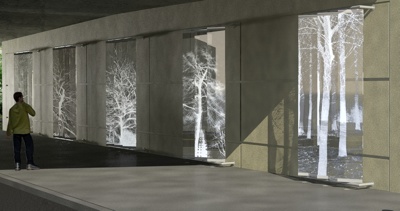
An image of proposed artwork by Catherine Widgery below East Stadium bridge, along South State Street.
Fabrication will begin later this year, but installation will likely occur in the spring of 2015.
Project Updates: Kingsley & First Rain Garden
The foundations for sculptures in a rain garden at the southeast corner of Kingsley & First were installed in early June. The rain garden itself is already in place, with the sculptures to be installed in late July.
At their Aug. 28, 2013 meeting, commissioners had approved Joshua Wiener‘s schematic design for public art at a planned rain garden. [.pdf of staff memo, including itemized budget] The Denver artist has been working with landscapers to incorporate public art into the new rain garden, which is in a floodplain. The project has a $27,000 budget, though the artist’s contract would be for $23,380.
Wiener’s sculptures show the outlines of five fish. They’re small mouth bass, in different sizes, made of white epoxy-painted steel and pointed toward the Huron River. “Pretty soon, there’s going to be a lot of big fish on the site,” Connie Brown told commissioners. She’s spearheading communications about this installation, including an event tied to the completed project, with the artist attending.
Project Updates: Coleman Jewett Memorial
A bronze replica of an Adirondack chair made by Coleman Jewett will be located at the Ann Arbor farmers market. Jewett was a long-time local educator who died in January of 2013. After he retired, he made furniture that he sold at the Ann Arbor farmers market. AAPAC has committed $5,000 in city funds to the project, which has a total project budget of $36,000. Other funds will be raised from private donations, including a contribution from the Old West Side Association.
Marsha Chamberlin reported that as of June 18, the project had raised $26,972 in contributions, including the $5,000 that has been committed by the city. Estimates from three foundries came in at about $25,000, so there’s enough money at this point for the project to move ahead, she said. To raise additional funds, a party was being planned later this month at Bill’s Beer Garden for alums from Tappan Middle School, where Jewett was assistant principal.
Chamberlin and Bob Miller also attended the Juneteenth event at Wheeler Park on June 14, and talked to people there about the project. Solicitations for the project will also be made outside of Kerrytown Market & Shops, next to the farmers market. And Chamberlin is planning to do a spot on Community Television Network to promote the memorial.
The city issued an RFP (request for proposals) on June 11 to select the artist or art foundry that will cast the memorial. Bids are due on Aug. 7. [.pdf of RFP]
Chamberlin said the goal is to raise about $40,000 to cover the cost of the fabrication and installation. There’s been one major gift of $10,000, but most of the contributions have been in the $100 range. “This is not like the money’s just rolling in, in big numbers,” she said. “But we’re diligently working away at it.”
Project Updates: Canoe Imagine Art
Canoe Imagine Art, a community art project, is intended as a temporary art display in downtown Ann Arbor using old canoes from the city that would be repurposed as public art. The installation of an estimated 25-30 canoes was expected to take place in fiscal 2015 or 2016, depending on funding. The project has received a $21,000 grant from the Michigan Council for Arts and Cultural Affairs, and organizers plan to raise additional funds from private donors.
AAPAC originally approved $10,000 in funding for the project, at its Sept. 25, 2013 meeting. It was to be used as a portion of matching funds for the state grant, with the remaining $11,000 in matching funds to be raised through donations. However, the city council voted to allocate the entire $21,000 in city funds to match the state grant. That action came at the council’s March 3, 2014 meeting.
A written report – part of the June 18 meeting packet – gave an update. The city has asked the Arts Alliance to administer this project. The Arts Alliance plans to seek an extension of the MCACA grant, to redefine the scope of the project.
The project was not discussed by commissioners on June 18.
Project Updates: Arbor Oaks Park
This project is being undertaken in partnership with Bryant Neighborhood Association and the nonprofit Community Action Network, which is under contract with the city to run the Bryant Community Center. It will involve participation of the neighborhood in the design and creation of artwork. The scope of the work will depend on the availability of funds.
The city applied for a grant from the Southeast Michigan Community Foundation, but it was not awarded to the project. Another grant application was submitted by the Community Action Network to the NEA Challenge America Fast-Track program, but those grants won’t be announced until December. No city public art funds have been allocated.
AAPAC member Nick Zagar is working with the project’s task force, but he has not attended an AAPAC meeting since January.
Donation of Public Art
At AAPAC’s April 23, 2014 meeting, John Kotarski had proposed that the city accept three pieces of donated art from Jim Pallas, an established Michigan artist and friend of Kotarski’s.
The pieces were proposed to be located in the lobby of the Justice Center, in the atrium of city hall, and outside of city hall. Other commissioners had seemed supportive of the idea, but some expressed concern that the proposal wasn’t following AAPAC’s guidelines for accepting gifts of art, which include setting up a review committee.
Kotarski had reported that the Ann Arbor Downtown Development Authority has offered a $500 honorarium to Pallas for each donated piece. Kotarski said the three pieces have a total estimated value of $100,000. He also mentioned that Pallas’ daughter, a law professor, knows city attorney Stephen Postema and that they had “made arrangement to resolve any legal issues necessary to facilitate this donation.”
After discussing it at length on April 23, commissioners had agreed that AAPAC chair Bob Miller would work with Aaron Seagraves, the city’s public art administrator, to set up a gift selection committee to review this proposal and make a recommendation to AAPAC. Commissioners did not officially vote on the item, however.
The May meeting for AAPAC was subsequently canceled. There was no mention of the donation at the June 18 meeting.
Responding to a query from The Chronicle, Craig Hupy – the city’s public services area administrator – indicated that no further action would be taken regarding the proposal.
Public Commentary
The only speaker during both opportunities for public commentary was Changming Fan, who in recent months has been attending meetings of many city boards and commissions. He spoke about his company, TiniLite World Inc., which is based in Ann Arbor. The firm is the innovator, producer and supplier of new technology called TiniLite, he said. It’s a lighting display using LED lights, cell phones, and wireless Internet. He called it the light of art, and the art of light, and hoped that the city would use the technology for the public’s benefit. He encouraged the city to pursue the strategy of funding public art through public, private and crowdfunding sources.
Commissioners present: Devon Akmon, Connie Brown, Marsha Chamberlin, John Kotarski, Bob Miller, Kristin “KT” Tomey. Also: Aaron Seagraves, the city’s public art administrator and Craig Hupy, public services area administrator.
Absent: Jim Simpson, Nick Zagar.
Next regular meeting: No additional meetings are scheduled at this time.
The Chronicle relies in part on regular voluntary subscriptions to support our artful coverage of public entities like the Ann Arbor public art commission. Click this link for details: Subscribe to The Chronicle.






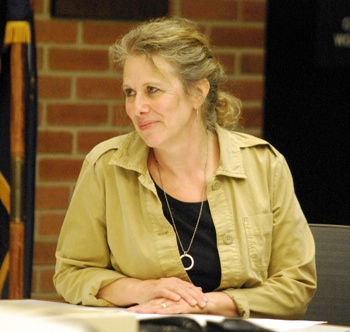
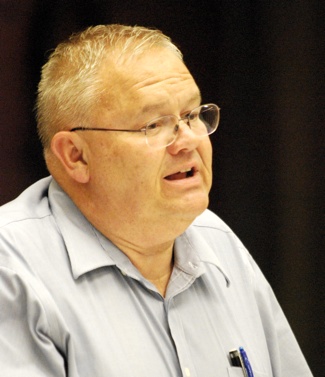
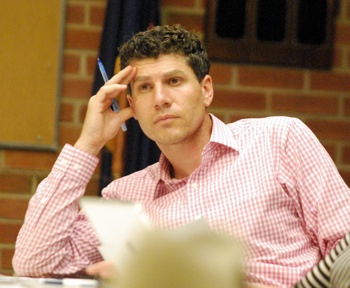
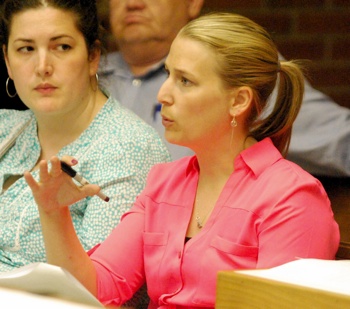
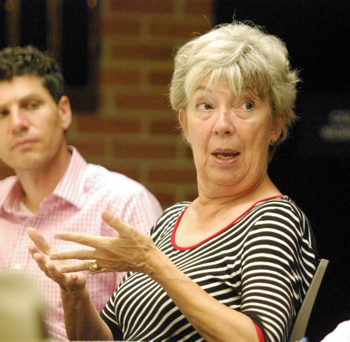



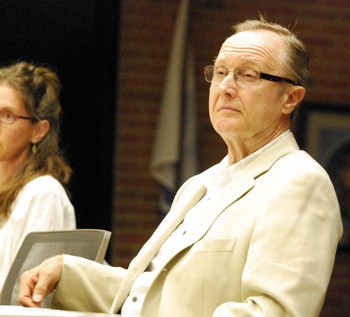
Oh no! I had hoped that the shrinkwrapped traffic signal boxes were out with the transfer of the Percent for Art money. Can’t we at least have an online poll or something?
This type of “art” is just visual clutter, in my opinion. I noticed the other day that one of the fire hydrants painted in an earlier DDA project has become rusted and is now doubly unattractive because of the painted blobs on it.
Requiescat in pacem.
Not only are those boxes going to be visual clutter, but they are waaaay over-priced. $950 for how many square feet of vinyl wrap? Those boxes are 3′x4′x2′ right? So that is 52 square feet, retail on printed vinyl is $9/sq foot, max. That should be around $500. Not to mention the 40% administration fee! Nothing against the artists making a buck, but $1450 licensing fee seems a little steep, too. I would think we could do better since it is exposure for artists – How much money can one city waste in pursuit of public art? Like many, I am glad to see our time with these folks is drawing to an end.
Would love to see these vinyl wraps created by teens from the Neutral Zone teen center whom are brilliantly taught and supervised by the incredibly creative Mary Thiefels of Tree Town Murals. And this would also not likely require a 40% administration fee.
I’m more than a little dismayed that the art commission seems to be just giving up, just hanging around to see if anybody will tell them what to do.
I was under the impression, and bolstered by my experience on various city commissions, including the art commission’s predecessor, that people served on commissions because they wanted to do something, accomplish something. The only thing worse than giving up is, I suppose, not bothering to show up at all, which, I gather, some of the commissioners chose to do.
There are plenty of ways to encourage and create public art. If necessary, search for private funding. If the commissioners don’t have a vision of their own, find someone who does have a vision. If city council is mired in other issues, get cracking anyway. There are a million reasons not to do something, and there are almost always ways around those kinds of obstacles.
I also think the commissions position on art donations is very short-sighted. Some of the best art in the city was donated, long before there was a commission. I think the city should be open to all donations. If they aren’t well received when displayed, we can put them in a warehouse, along with all the other gifts the city gets that aren’t particularly prized. Or, sell them off at a city yard sale, like the city does, or did, with other unneeded equipment.
I think the art commission should be telling city council what the city needs for public art, not the other way around.
Bob Elton